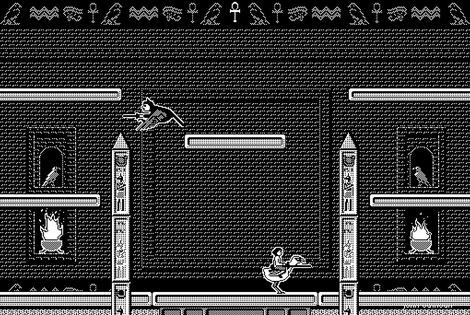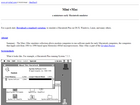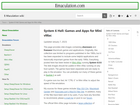Autor Mini vMac'a, emulatora klasycznych komputerów Apple z procesorem motoroli, produkowanym w okresie '84 - '96 (Macintosh Plus, Macintosh 128K, 512K, 512Ke, SE, Classic i SE FDHD) opublikował kolejną już wersję swojego programu.
Oprócz nowych portów i paru bugfixów nie ma większych zmian.

Glypha 3.0 (Soft Dorothy, 1990)
Mini vMac 3.3.2 01.07.2012
New features in default compile
- * More operating systems are officially supported by Mini vMac:
- FreeBSD on x86-32 (Using “-t fbsd” in the build system)
- FreeBSD on x86-64 (“-t fb64”)
- OpenBSD on x86-32 (“-t obsd”)
- OpenBSD on x86-64 (“-t ob64”)
- NetBSD on x86-32 (“-t nbsd”)
- NetBSD on x86-64 (“-t nb64”)
- Dragonfly BSD on x86-32 (“-t dbsd”)
- Dragonfly BSD on x86-64 (“-t db64”)
- OpenIndiana on x86-32 (“-t oind”)
- OpenIndiana on x86-64 (“-t oi64”)
- Linux on ARM (“-t larm”)
- Linux on SPARC (“-t lspr”)
- Minix 3.2 ("-t minx")
- These ports adapt the same X Windows code as the Linux port, and should have the same functionality, except currently not sound. The x86-64 versions are currently slower, for lack of assembly language tweaking, and should not be used if the x86-32 versions will work.
- The X versions can now play sound using the Open Sound System (OSS) API. (Usually using compatible implementations on each operating system, rather than the official OSS itself.) Sound is now enabled by default on FreeBSD and NetBSD. Sound compiles without problems (using “-sound 1”) on Dragonfly BSD and OpenIndiana, but I have not been able to test on these yet. Getting sound on Dragonfly BSD seems to require some manual setting up. OpenIndiana doesn't seem to produce any sound at all in VMware Fusion. Sound also compiles without problems on OpenBSD, but it doesn't work - setting the desire sample rate fails. Minix doesn't really seem to support sound yet. It is also possible to use the OSS API on Linux, using the new “-snd-api” build system option.
- The X versions now will try to look in the folder contain the application for the ROM image, like the Macintosh and Windows version do. (And also for disk1.dsk and so on files.) If the application directory can not be determined, the current directory is used as before. This is implemented for Linux, FreeBSD, NetBSD, Dragonfly BSD, and OpenIndiana, but not OpenBSD and Minix.
- The X versions now have a new command line option “-d [directory_path]”, in which [directory_path] is used instead of the application directory when looking for the ROM image, and disk1.dsk and so on files.
- The X versions now have a new command line option “-n [app_name]”, in which [app_name] is used instead of the application name for the title of the Mini vMac window.
- The X versions now supports a central ROM folder like the Macintosh and Windows versions have. If “~/.gryphel/mnvm_rom” exists, Mini vMac will look there for the ROM image. If it isn't there, it will look in the application directory. (And the -r command line option will override both.)
Changed behavior in default compile
- The Linux version dynamically loads the ALSA library to play sound, so that Mini vMac will still run, without sound, even if ALSA is not installed. (This technique was seen in SDL.) So by default the Linux version is now compiled with sound, matching the Mac and Windows versions.
- In the Linux version, when playing sound with ALSA, snd_pcm_delay is no longer called. The delay until a sample is played is not really relevant. What Mini vMac needs to know is time to buffer underrun. So Mini vMac now looks at buffer size minus the available space in the buffer, which may be more useful, for the purpose of preventing buffer underrun while minimizing latency.
- The X versions now use advisory locking to refuse to open for writing a disk image that has been opened for writing by another copy of Mini vMac. Previously, the X versions of Mini vMac could open an already opened disk image, likely corrupting the image. If Mini vMac can only open a disk image read only, such as because the user has locked the file, then the advisory lock is not used, and multiple copies of Mini vMac can use it.
- The X versions now try to use the application name to set the title of its window, like the Macintosh and Windows versions have. (If the application name can not be determined, “Mini vMac” is used as before.) This is found at the same time as the application directory, and is implemented for the same operating systems.
- Command line arguments are now scanned before looking for disk1.dsk and so on files. This is necessary for the new “-d” option to work, and has the side effect that if disk images are specified on the command line, they will be opened first. If there are images on the command line, Mini vMac will now not bother to look for disk1.dsk at all.
- The “-l” (or “/l” on Windows) command line option is removed. The “-speed z” option to the build system should be used instead. The command line option was from before the build system existed, and the decision made to favor build time options over run time options.
Bug fixes in default compile
- The Windows version now maps the Enter key on the numeric keypad to the Macintosh Enter key. It can now distinguish that key from the Enter key on the main keyboard, which is mapped to the Macintosh Return Key. There was previously no way to type the Macintosh Enter key. Thanks to “Alex” for pointing out this issue.
- In the Windows version, in Full Screen Mode, the check for whether a key down event is an autorepeated key is incorrect. So potentially keys could have been ignored when they shouldn't have been. I've removed the check, since it isn't clear how to do so correctly (when using a "low level keyboard hook"). This doesn't affect Macintosh emulation, since there is an additional check for redundant events. It can affect the Control mode, such as when holding down Control-M.
- In the Linux version, using ALSA to play sound, snd_pcm_start was called before putting any sound samples in the ALSA buffer. This could cause stuttering at the beginning, or according to one report, prevent sound from working at all.
- The emulated clock was not properly initialized, and was only correct after the first “second” interrupt.
- If the emulated screen is too big to fit on the real screen (when autoscroll is available), if the area of the emulated screen that has changed doesn't intersect the visible area of the emulated screen, then an invalid rectangle was used for drawing. I discovered this when trying out Vector Linux 7, which seems to have some extra debugging checks.
- In unlikely circumstances, in Full Screen Mode, autoscroll may not scroll to show the last row of pixels at the bottom or the last column of pixels on the right.
- If the host computer is not fast enough for Mini vMac to run at 1x speeds, then Mini vMac would not run smoothly, pausing for a few seconds periodically. The test for this situation was incorrect, and a one byte counter would overflow. (Have such counters as small as possible makes it easier to detect bugs like this.)
- In X Window versions of Mini vMac, when using the Mini vMac extension to create a file on the host system, such as with ExportFl, a save dialog is not implemented. Previously the file would simply be created in the application directory with the asked for name. This was not safe, at worst it allows a program running in Mini vMac to replace the Mini vMac application. So now files will instead be created in a folder named "output" in the directory containing the application. This folder will be created if it does not exist.
- In the Microsoft Windows version, if a path to a disk image is passed to Mini vMac on the command line that is longer than is legal for a path, a buffer overflow results.
- The Windows CE version suffered bit rot. It now compiles and at least works on the Microsoft Device Emulator with Windows Mobile Version 5.0. I have no idea if it works on real hardware. Does anyone care? (Windows Mobile was discontinued and replaced by Windows Phone.) This port was starting to interfere with maintaining the main Windows version, and the choice was to remove it entirely or make it maintainable.
Build System
- Added build system option “-t mx64” for Apple's X11 implementation on x86-64. (Previously x86-32 and PowerPC were supported.)
- Added build system option “-t cygw” for Cygwin/X for Microsoft Windows. Cygwin can also be used to compile the regular Microsoft Windows version with “-t wx86 -e cyg”.
- Added build system option “-t irix” for IRIX by Silicon Graphics, Inc., thanks to John Perkins.
- MinGW can be used to compile Mini vMac with build system option “-t wx86 -e mgw”. Since Bloodshed Dev-C++ is based on MinGW, “-t wx86 -e dvc -cl” would previously give similar results.
- Changed order of arguments to the link command when building the Linux version. It turns out there is a conventional order for how libraries should be specified, which I didn't know since I hadn't come a across a linker that cared until Ubuntu 11.10.
- The build system should now work properly in other emulators such as SheepShaver. It was anonymously reported that the build system would crash emulators. The test for whether the build system was running in Mini vMac (so that the resulting archive may be exported to the host) was not good enough.

![[Apple] Mini vMac 3.3.2](/Photos/www/picphoto/04beac451.jpg,134)

 Mini vMac a miniature early Macintosh emulator
Mini vMac a miniature early Macintosh emulator (updated November 19, 2011) This page provides disk images containing shareware and freeware Macintosh games and applications from the 1980s (and a select few from the early 1990s). Everything posted here has been tested in Mini vMac running System 6.0.8. The disk images should be usable in Mini vMac running on any host system.
(updated November 19, 2011) This page provides disk images containing shareware and freeware Macintosh games and applications from the 1980s (and a select few from the early 1990s). Everything posted here has been tested in Mini vMac running System 6.0.8. The disk images should be usable in Mini vMac running on any host system.